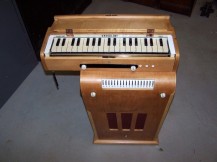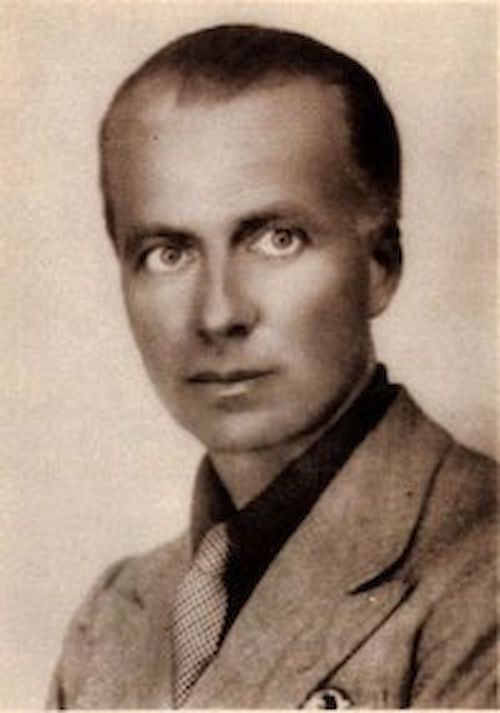Giacinto Scelsi: Sound Messenger 1905-1988
“Future development of music will move towards spiritualization and implies recognizing the special character of individual sound. If we immerse ourselves in sound, it reveals three, five sounds or more; a single sound unfurls into melody and harmony leading directly to the spiritual world. One aspires to the understanding of sound in its spiritual depth and one wishes to go from the natural to the spiritual element.”
– Rudolph Steiner
The second half of the 20th Century is unthinkable without Giacinto Scelsi. A composer who was many years ahead of his time, Scelsi did not receive widespread recognition until the late 1980’s when the ISCM Festival in Cologne presented his works to endless acclaim, though he had been composing prolifically since the 1930s. Scelsi’s contribution to music of the 20th Century is comparable to that of Cage, Xenakis and Rudhyar, but his importance as a mystical visionary, or “messenger between two worlds” can only be compared to the likes of fellow modern Pythagoreans R. Buckminster Fuller, G. I. Gurdjieff, Timothy Leary, Nikola Tesla, William Burroughs, Wilhelm Reich, William Butler Yeats, and Arthur Machen.
Scelsi was an intensely private person whose life was shrouded in mystery. Although he apparently dictated an autobiography on tape, it is as of now unavailable. The few facts known about him are primarily from interviews with people that he worked with, and the threads of this scant data reveal a fascinating person of immense spiritual power and charm, a modern-day shaman who achieved illumination after years of yogic meditation and a consciousness altering near-death illness. Scelsi applied his “supramental” talents towards the task of transmediating a vast body of etheric knowledge from a higher plane into a “growling, sliding, writhing, meditative, formless, melodyless, harmonyless music”1 and was able to create something “unlike anything else in European history.”2
ACCIDENTAL SHAMAN
Giacinto Scelsi was born January 8th, 1905 to an Aristocratic family living on a large estate in La Spezia, near Naples in southern Italy. Not much is known of his formative years except that he had a classical education, and little formal music training. In his 20’s, he studied composition with Walter Klein, a student of Berg’s and with Egon Koehler in Geneva. During World War II, Scelsi moved to Switzerland, and published several articles on music aesthetics. The works now classified as his First Period (1929-1948) were influenced by Scriabin and Berg and are defined by a marked use of counterpoint and dodecaphony. The majority of the music in this period is for piano, on which Scelsi was a self-taught virtuoso.
Beginning in the early 1940’s, Scelsi became involved with Eastern religions, and took up yoga and meditation. It is also rumored that Scelsi traveled widely in the Middle East, and throughout Tibet.
“Since the 1940’s G.S. had been deeply involved with Eastern religions. He practiced yoga as well as other religious disciplines and studied the works of Blavatsky and Gurdjieff, but he was particularly influenced by the teachings of Sri Aurobindo and La Mere. He believed that various meditation techniques, such as intoning the OM, enabled him to enter a different vibratory realm. For him, sound in its purest vibration was a potent force that has an extremely powerful influence on people. He was convinced that through meditation and improvisation, he could become a channel for higher forces which would enable the creation of works that were otherwise impossible through ordinary composition.”3
Scelsi abruptly ceased composing in 1948 due to the onset of a mysterious illness, and from1948 to 1952 withdrew into a chrysalis state, during which he experienced a profound psychological metamorphosis. No one currently knows what Scelsi suffered from, but he spent several years in a hospital only to recover through his own therapy of meditating on a repeated piano note. One composer who knew Scelsi, Dary John Mizelle, has opined that Scelsi’s illness was brought on by the composing of too much serial music, and although this could be the case it should be noted that Scelsi’s wife had left him around this time. I would conjecture that Scelsi’s mysterious illness was in fact not specifically caused by his wife leaving him or by his serial compositions, but as the result of a mutational process that occurred during a shamanic illness-rebirth transition. This shamanic process, according to Robert Anton Wilson, occurs in three stages and can be either accidental (in the case of Scelsi) or part of a ritual.
1. In every tribe there are occasional shamans who are prone to visions and illuminations.
2. These shamans usually begin having their visions during or right after a prolonged illness.
3. After recovery, the shaman has odd psychic abilities––“wild talents” as Charles Fort said.
The whole process can be condensed to the formula, near-death plus rebirth on a higher level.4 (emphasis added)
Scelsi’s shamanic transition was eerily similar to that of Nikola Tesla’s, who was described by Robert Anton Wilson as a “secular shaman.” Tesla was described as having visions in which he went into a trance and talked to entities that no one else could see. Like Tesla, Scelsi experienced “sound visions” during which he could channel unheard higher forces. Like Tesla, Scelsi suffered a mysterious illness. After the shamanic transition, Tesla “saw” that everything in the universe obeys the law of Octaves first suggested by Pythagoras, and could literally “see” in perfect detail any machine he thought about, right down to microscopic measurements and dimensions. Scelsi’s enlightenment led him to the conclusion that all music since Pythagoras had been in error, and that music should consist of the analysis of a single note and its fundamental overtones. Like Tesla, Scelsi exhibited an amazing talent for being literally able to conceive and improvise entire works in a fully developed and completed form:
“He would sit down, turn on the tape recorder and start, and it would build to an incredible proportion, and just stop, and be a complete form. You would never have the feeling, as you do with nearly all improvisers, that the musician is looking for material, searching.”5
It was at this point that Scelsi stopped referring to himself as a composer, and began describing himself as a “messenger between two worlds.” The quantum jump in neurological awareness that followed Scelsi’s shamanic transition led to his neo-Pythagorean epiphany, to his one-note therapy, and finally inside the vibratory universe from where he drew his inspiration. Scelsi made real Steiner’s prediction that sound could be a gateway to higher planes and went even further, transmediating energies from higher planes into sound.
SONIC TRANSMEDIATION
“He who does not penetrate to the interior, to the heart of sound, even though a perfect craftsman, a great technician, will never be a true artist, a true musician” -Giacinto Scelsi
Scelsi’s method of “sonic-transmediation” or translating messages from a higher plane into music involved meditating in such a way as to allow the Kundalini chakra, “what he considered to be the primal vibration that was the original impulse for music”6 to become a receptor for higher forces and making that energy move and manifest through an instrument. The instrument that Scelsi ultimately chose for this purpose, and used to create most of his chamber music and orchestral pieces, was the Jenny Ondioline, a vacuum tube based instrument consisting of an oscillator and a small touch sensitive keyboard. The Ondioline could produce complex waveforms via a series of filters as well as a “touch wire” which enabled the player to alter the attack with a vertical finger movement or add glissando or modulation by horizontal movement. Volume was controlled by a knee lever. (Georges Jenny invented the instrument in 1938 during a treatment for tuberculosis. Later he started the company “Les Ondes Georges Jenny”, and continued to redesign and sell the instrument until his death in 1976. See picture.)
According to Frances-Marie Uitti, Scelsi
“could make a glissando or a vibrato…and could play quarter-tones so he could have total mastery over a line in a string quartet, for example. That way he didn’t labor over the page. It was a tool for radical musical thought.”7 (Emphasis added)
Scelsi had found the perfect tool for translating his vibratory universe into sound, and through the years became a master of this instrument, exploiting every nuance it was capable of through its array of dials, keys, pedals, buttons, and touch-wire.
“[He] explored the limits of extreme velocity, dynamics, range and duration. Many improvisations were centered on sudden variations in the dynamic texture, giving a sense of great power and vitality. There were also a number of monodic works, some highly ornamented around a basic melodic line. Others used extreme speeds of oscillating repeated figures, and still others incorporated dramatically pulsating dynamics in the low register. He used glissandi of various speeds as well as quartertones. Two and three equally important voices were simultaneously explored, at times using microtones and at other times glissandi in slow durations.”8
 Sclesi was known to have combined two or more prerecorded Ondioline tapes, played back at various speeds or backwards, yielding works with complex overtones and highly sophisticated rhythmic accent patterns. Transcriptions of the Ondioline improvisations made in collaboration with Vieru Tostati, Frances Marie Uitti, Alvin Curran, and Sergio Caffaro would form the basis of Sclesi’s entire chamber and orchestral output.
Sclesi was known to have combined two or more prerecorded Ondioline tapes, played back at various speeds or backwards, yielding works with complex overtones and highly sophisticated rhythmic accent patterns. Transcriptions of the Ondioline improvisations made in collaboration with Vieru Tostati, Frances Marie Uitti, Alvin Curran, and Sergio Caffaro would form the basis of Sclesi’s entire chamber and orchestral output.
Scelsi’s process of transmediation didn’t end at transcription. To insure the integrity of the final stage of the compositional circuit, he worked closely with the performers who were to play his music. Suzanne Fournier and Frances Marie-Uitti have described the almost religious dedication that Scelsi insisted on from his performers. Scelsi did not want his music published for this reason, instead preferring to initiate any potential interpreters of his works in the concepts of Kundalini yoga, so that his music could correctly “act on the soul”9 and “vibrate the beings that receive it.”10 It is also for this reason that it is important to choose recordings and performances of Scelsi’s work carefully. Those who worked closely with Scelsi are the most reliable interpreters, including the conductor Jürg Wyttenbach, (whose recordings of the orchestral works on Accord are sadly now out of print) cellist Frances Marie-Uitti, pianists Suzanne Fournier and Marianne Schroeder, and violinist Carmen Fournier. Werner Bärtchi’s interpretations of the solo piano works are highly acclaimed, and recommended. Hearing his music is the most profound and informative Scelsi experience one can have, and always leaves one––in the words of Frances Marie-Uitti––“wondering about the mysterious source of this overpowering music.”11
Internet Resources:
Fondazione Isabella Scelsi: http://www.scelsi.it/
Discography through 1988: http://www.medieval.org/music/modern/scelsi/discs.html
Bibliography:
Wilson, Robert Anton: Cosmic Trigger; Final Secret of the Illuminati; Falcon Press, Las Vegas 1977
Uitti, Frances-Marie: Preserving the Scelsi Improvisations; Tempo, No. 194/ October 1995 (Italian Issue)
Uitti, Frances-Marie: Giacinto Scelsi; from the liner notes to Trilogia/Ko Tha; Etcetera KTC1136
McComb, Todd: Various posts to the Internet, available at http://www.medieval.org/music/modern/scelsi.html
Gann, Kyle One Note Wonder Village Voice, February 25, 1997
Image of Jenny Ondioline from http://electro-music.com/forum/topic-13360.html
Notes:
1 Gann
2 ibid
3 Uitti/Tempo
4 Wilson, p138
5 Uitti/Tempo
6 Dary John Mizelle (interview)
7 Uitti/Tempo
8.ibid
9. Uitti/Giacinto Scelsi p.1
10. ibid
11. ibid
Next: Dary John Mizelle on Scelsi »
- Giacinto Scelsi: Sound Messenger 1905-1988
- Dary John Mizelle on Scelsi
